Grand Seiko Blue Snowflake Reference SBGA407: On The Wrist
by Chris Malburg with photos by GaryG
The Grand Seiko Spring Drive is a quartz watch. Wait. No. Okay. It’s a battery-operated watch. No again. It’s somewhat of a hybrid. No owner of a Grand Seiko Spring Drive will ever change batteries. There are none.
While it doesn’t have the precision of a pure quartz watch, it’s among the most accurate mechanical watches in the sub-$10,000 market (+/- 1 second per day or less; my experience was less).
That’s what interested me about the Grand Seiko Spring Drive. GS is known for its craftsmanship, basing its micro-mechanical designs on tolerances down to one-hundredth of a millimeter (think less than the diameter of a human hair). The final adjustments and refinement of the components are all completed by hand.
Grand Seiko maintains that no machine can match the skill of its craftspeople; their skill gives Spring Drive its extreme precision. After spending some quality time with it, I agree.
With this introduction, I wanted to learn a little more about the Spring Drive. Specifically, one model that caught my eye: the Blue Snowflake. Some call it the Skyflake, since blue snow is hard to come by.

The gorgeous blue dial of the Grand Seiko Spring Drive Blue Snowflake
So we rang up Grand Seiko and asked if they might lend us a watch to try. No. Sorry. Apparently, the Blue Snowflake is too popular to send to the media. But we can send you a non-working example. No, thanks.
I walked into the Beverly Hills Grand Seiko boutique and chatted up the manager Alexander Friedman and his associate, Xavier Sanchez. They were as nice as they could be. And, yes, they just so happened to have a Blue Snowflake – it had arrived two hours previous and, lo and behold, wasn’t yet spoken for. Lucky me.
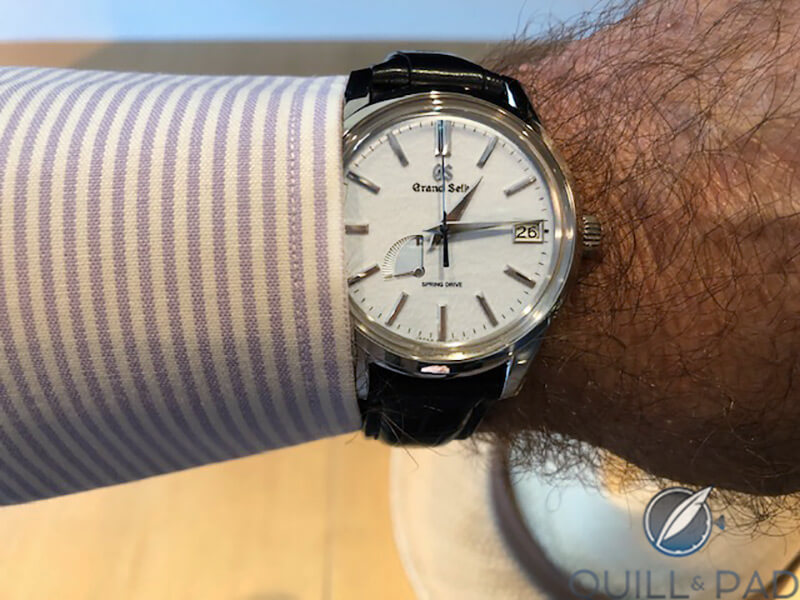
Grand Seiko Blue Snowflake on the wrist (photo courtesy Chris Malburg)
After a week on my wrist, here are my impressions of this watch. Fair warning: I fell in love with it on several levels. Yes, there are some things I’d change, which I’ll get to. However, these are minor compared to what this piece has to offer especially at a price point of $5,800.
That is by no means inexpensive. However, sub-$6,000 barely scrapes the entry level for many manufacturers.
Grand Seiko Blue Snowflake: dial
The dial is manufactured in-house, in the company’s Shiojiri dial workshop. The snow-like effect comes from stamping the pattern onto a dial blank and then adding several layers of slightly translucent coating to reveal the texture beneath.
The technique is similar to the way the Japanese make traditional water paintings. The result is the rough appearance of a snowy field you see on the dial.
Necessary clutter?
There are those who prefer no power reserve indicator here. For purists, its presence just blows the whole Zen effect. Some, on the other hand, may grudgingly accept the date window. They may not love it, but it’s not a deal killer either.
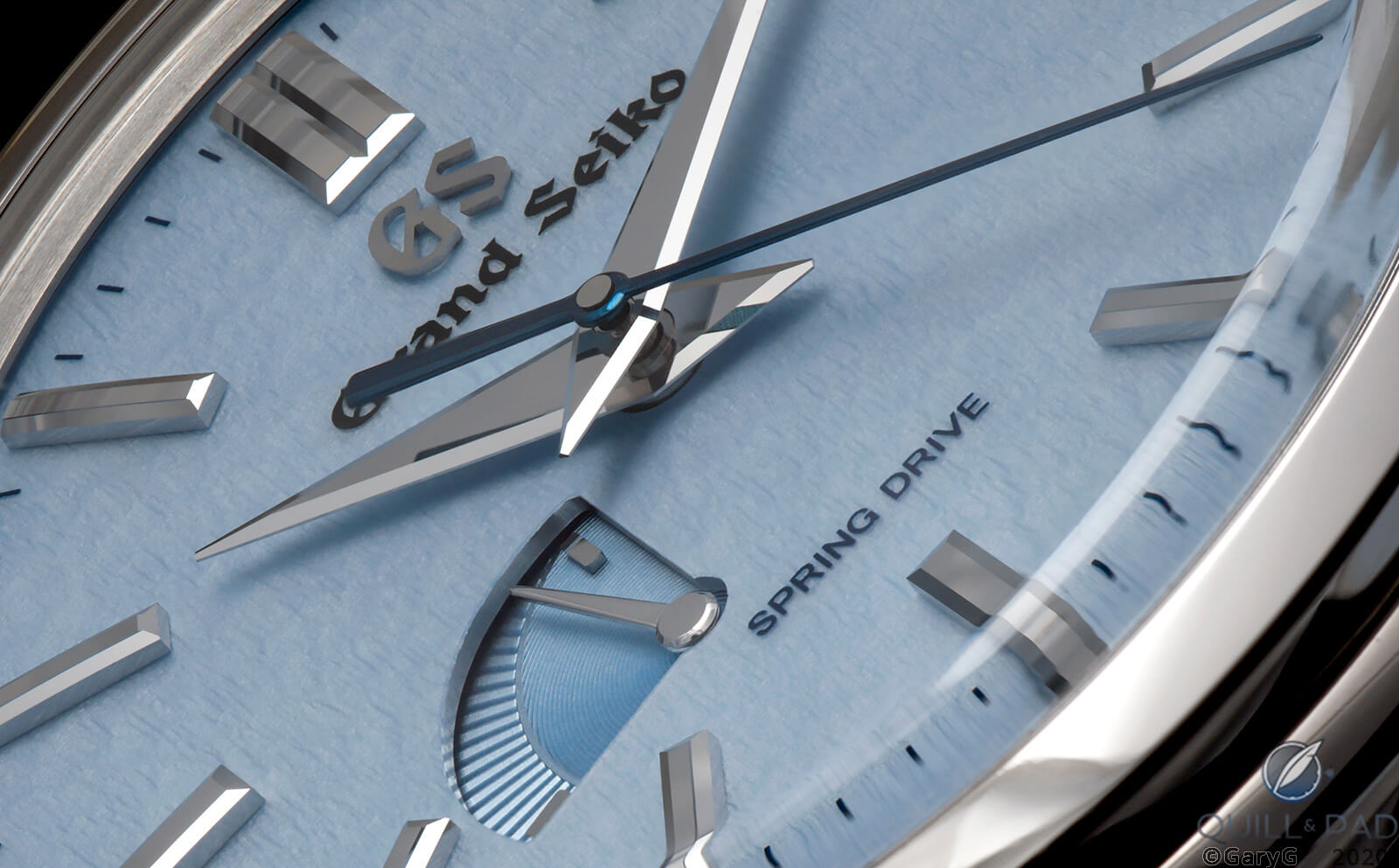
Power reserve indicator on the dial of the Grand Seiko Spring Drive Blue Snowflake
I understand. Without these two distractions the dial would be totally free of clutter, and we could enjoy the unobstructed view of the second hand gliding across the blue snow field. Wouldn’t that be something?
The power reserve meter correctly rises from bottom to top as the watch winds down. Facing the left dial side, the indication moves in a clockwise direction so that all hands rotate in the same direction. It would have looked odd the other way around.
There’s always a reason
Several in the business told me that there’s a reason for everything Grand Seiko does. Who am I to second guess the GS designers?
Still, I think they could have put the power reserve indication elsewhere or abandoned it entirely rather than clutter the beautiful dial. Repositioning or removing such an element of nonessential information makes sense to me given what I learned about the Spring Drive:
- If you keep it on your wrist or in a winder it will never run down, just like an automatic watch.
- If you pick up a watch you know has a power reserve indicator, you’ll glance at it before putting the watch on to see if you need to wind it. Right? Regardless of where the indicator is located, you still get the same information.
- As long as the Spring Drive is not at a dead stop, when you put it on it’ll wind right up in no time and you won’t have to even look at the power indicator for three days.
Hands
The hands and hour markers have wide and flat surfaces. Their highly polished, mirrored edges catch and reflect even the smallest rays of light. Together, dial and hands combine to create a very readable dial under most any light conditions.

Dial of the Grand Seiko Spring Drive Blue Snowflake
The second hand turned out to be one of my favorite features. It is blued steel. Depending on the light, it transcends from black to an electric blue. And it doesn’t jump from second marker to second marker like quartz watches; thanks to the Spring Drive, it sweeps in a single unrelenting, uninterrupted glide across the “snowy” blue dial in a much smoother way than even a high-frequency mechanical watch.

Grand Seiko Spring Drive Blue Snowflake
Markers
The 11 rectangular markers receive the same beveled mirror polishing, which allows them to work with the hands to reflect even the smallest amount of light. Truly, the ability to actually read the time in very low-light conditions is remarkable.
Date window
So far, the design vocabulary remains consistent. The date numbers are in a thin black font against a white background. I can’t be certain, but I’d say it uses the same font as the “Spring Drive” verbiage on the dial.
A nit-picky point here: I wonder why the designers chose to use a white background for the date window rather than matching the dial’s blue. Even the power reserve indicator uses the dial’s blue. Giving the same treatment to the date window makes sense to me.
Case
The case design is pure classical elegance. All surfaces have the brand’s own Zaratsu mirror polish. The lugs curve gracefully downward, giving the watch the perfect size appearance for my wrist.
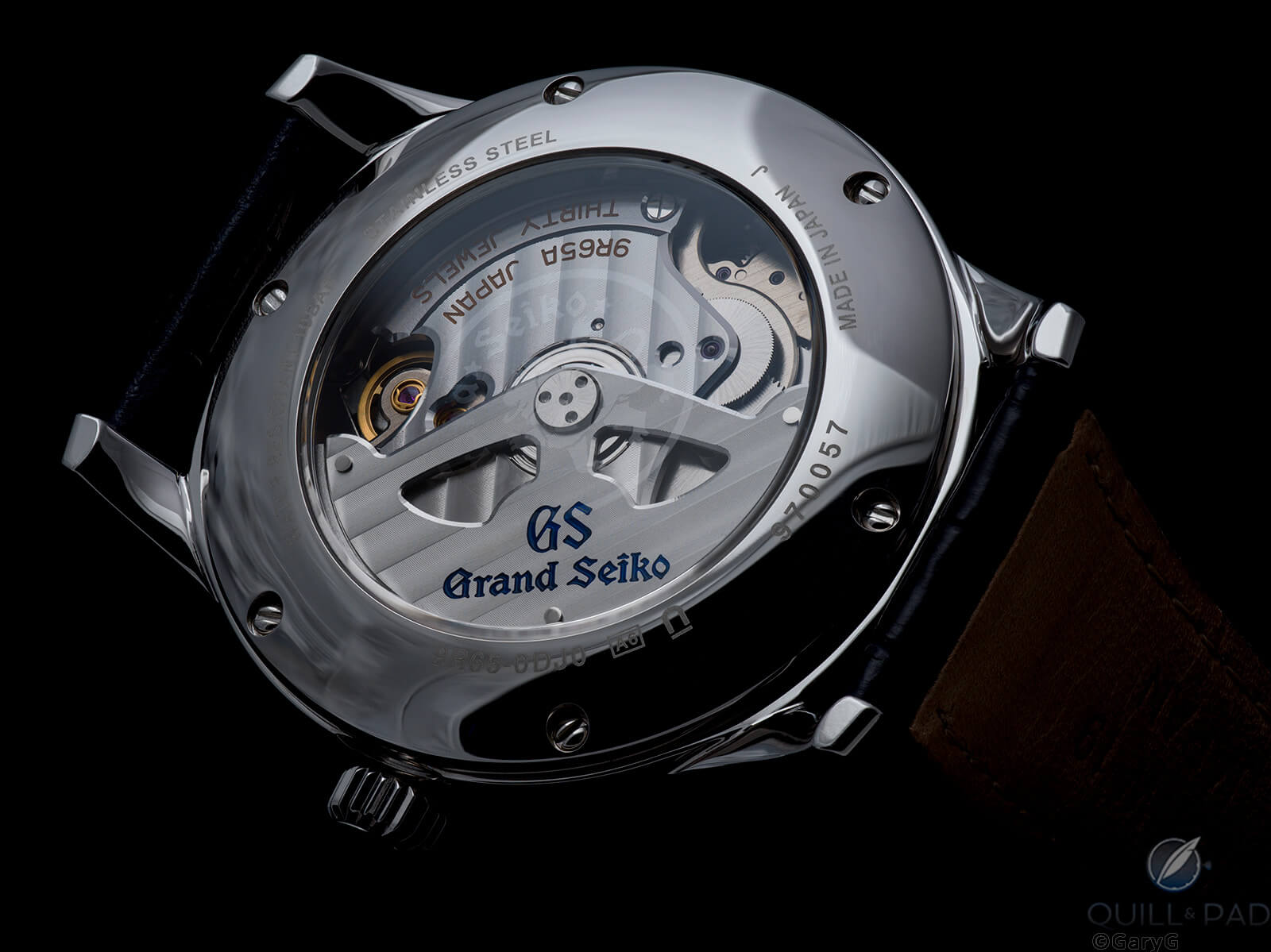
Spring Drive Caliber 9R65 powering Grand Seiko’s Blue Snowflake
Grand Seiko added a sapphire crystal display case back to show off the Spring Drive movement. Brilliant. Caliber 9R65 Spring Drive is an enormous technical achievement that everyone wants to see. The rotor along with some of the movement is decorated in what the Internet has taken to start calling “Tokyo stripes,” but what I would love to dub “Shinshu waves.”
With its blue crocodile skin strap, this is most certainly a dress watch that works for casual as well.
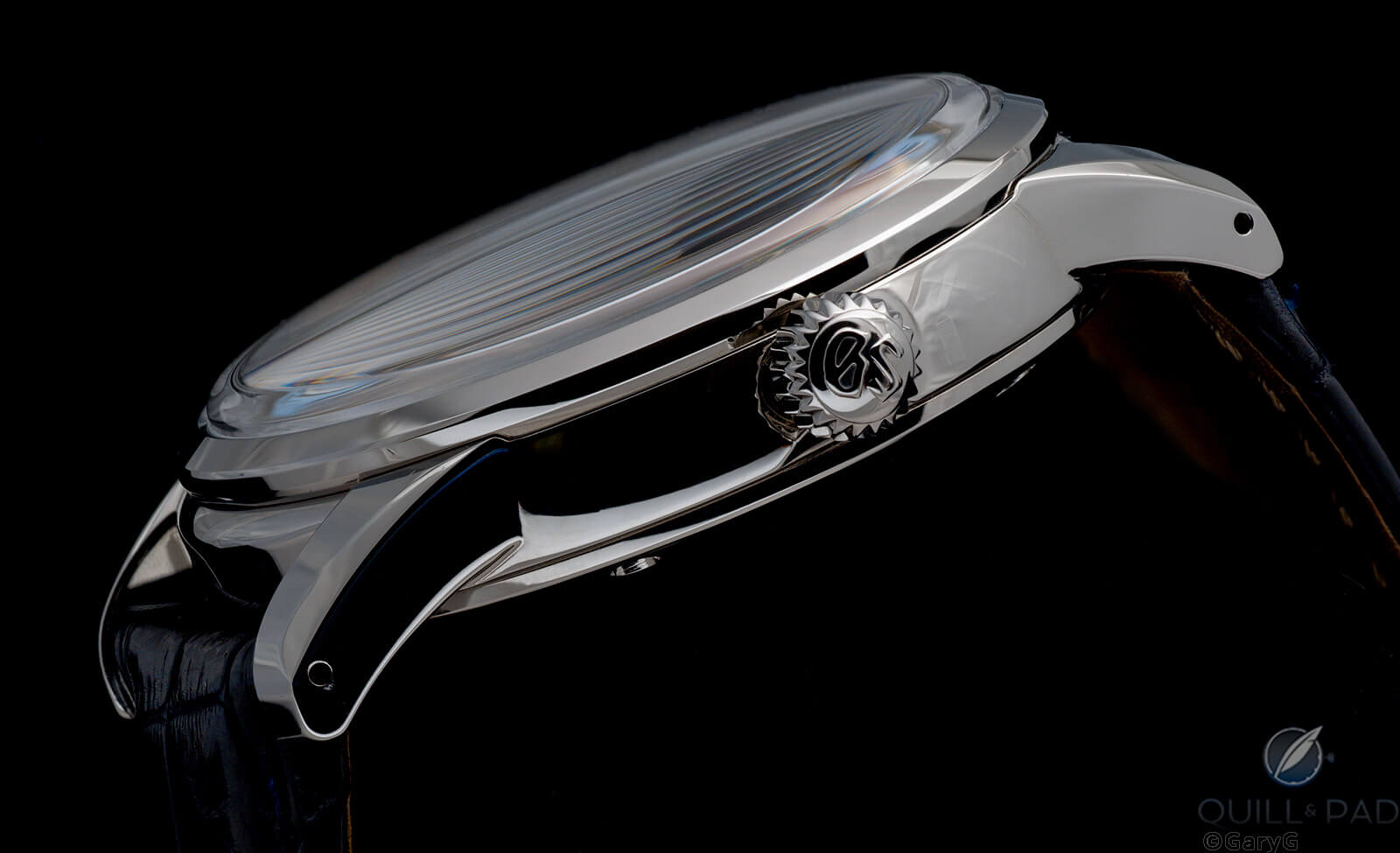
Close-up view of the Grand Seiko Blue Snowflake’s proprietary Zaratsu polishing
Crystal
A box-shaped sapphire crystal is slightly convex and rises above the mirror polished bezel. Grand Seiko’s decision to use the more costly box crystal is testimony that no expense is spared in designing and manufacturing this piece. The crystal also has an anti-reflective coating inside. This works nicely to remove exterior glare, allowing the dial furniture to sparkle.
Strap and buckle
The strap is blue crocodile with blue stitching. It’s a nice strap – high quality and quite comfortable. However, there are two issues that remain unexplained as to the strap and deployant buckle designs.
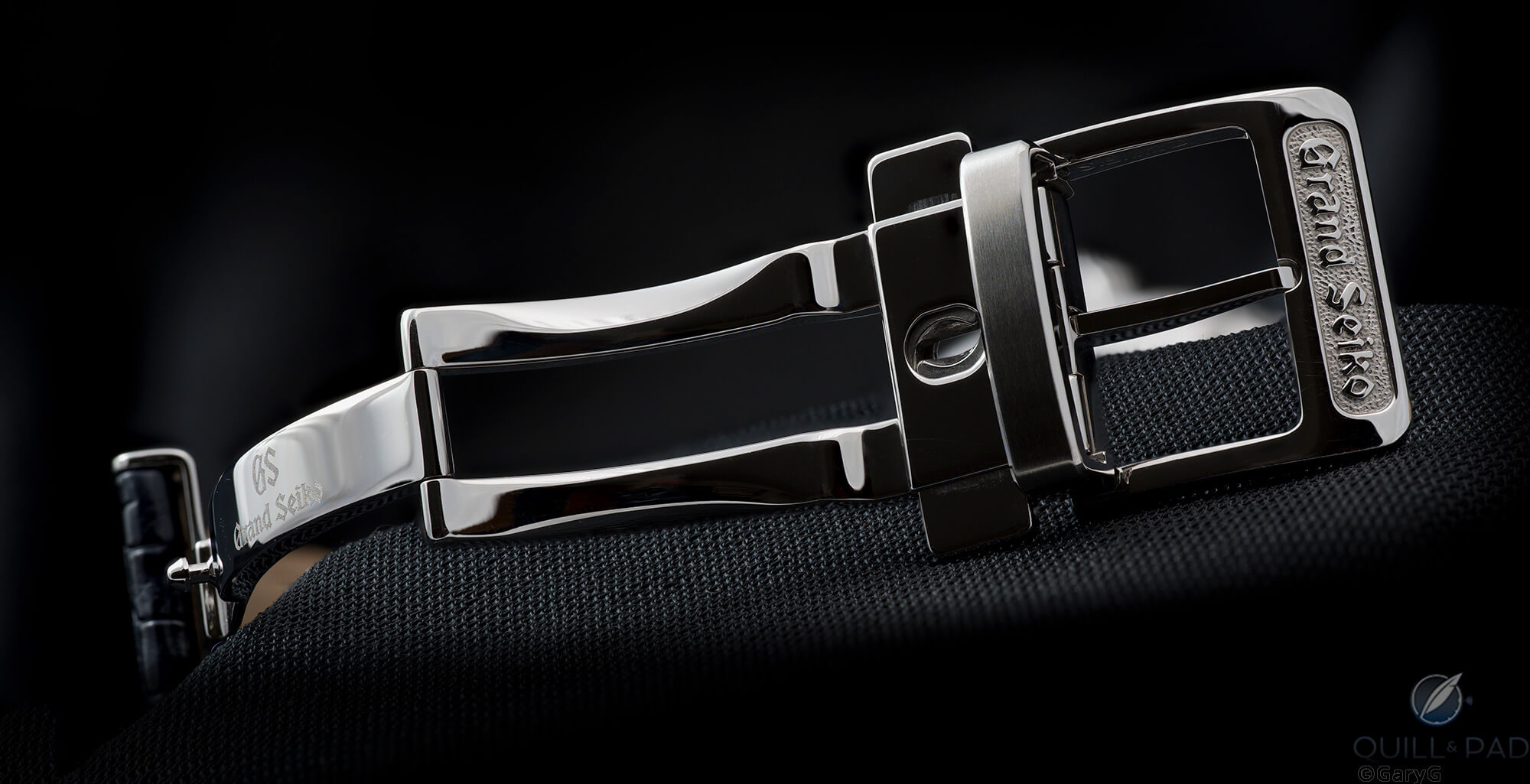
Deployant buckle of the Grand Seiko Blue Snowflake
First, the strap ends in a blunt curve. Why have such a boring end to this story when the entire design vocabulary on this watch bespeaks precision punctuated with sharp, pointed hands and perfect mirror finishes? Even the markers speak this language with their sharp, diamond-cut, right-angled corners. So why put a blunt end on the strap, one of the only parts we handle every day?
Second is the buckle. It’s a nice, serviceable deployant buckle in stainless steel. The two-fold mechanism works well by pressing two buttons on either side. The buckle hardware carries the same mirror polishing as the case and dial furniture.
It’s a nice touch. But there’s a brush-finished steel loop affixed to the buckle that the strap end passes through. This metal loop makes changing the strap length by passing the end through the loop a pain.
I believe I understand why Grand Seiko chose to use a steel loop here rather than the more commonly used leather. It’s to protect the more delicate polishing of the buckle in an area whose surface is exposed to constant wear and abrasion.
The result is that the entire deployant buckle is thicker than need be. Couple that with the long tail of the OEM strap and there’s far more attention drawn to this part of the watch than necessary. You cannot rest your wrist on a flat surface without feeling the steel loop’s uncomfortable bump beneath.
Further, the inner wrist side of the watch appears lopsided with both the long excess strap and the steel loop of the buckle bulging out.
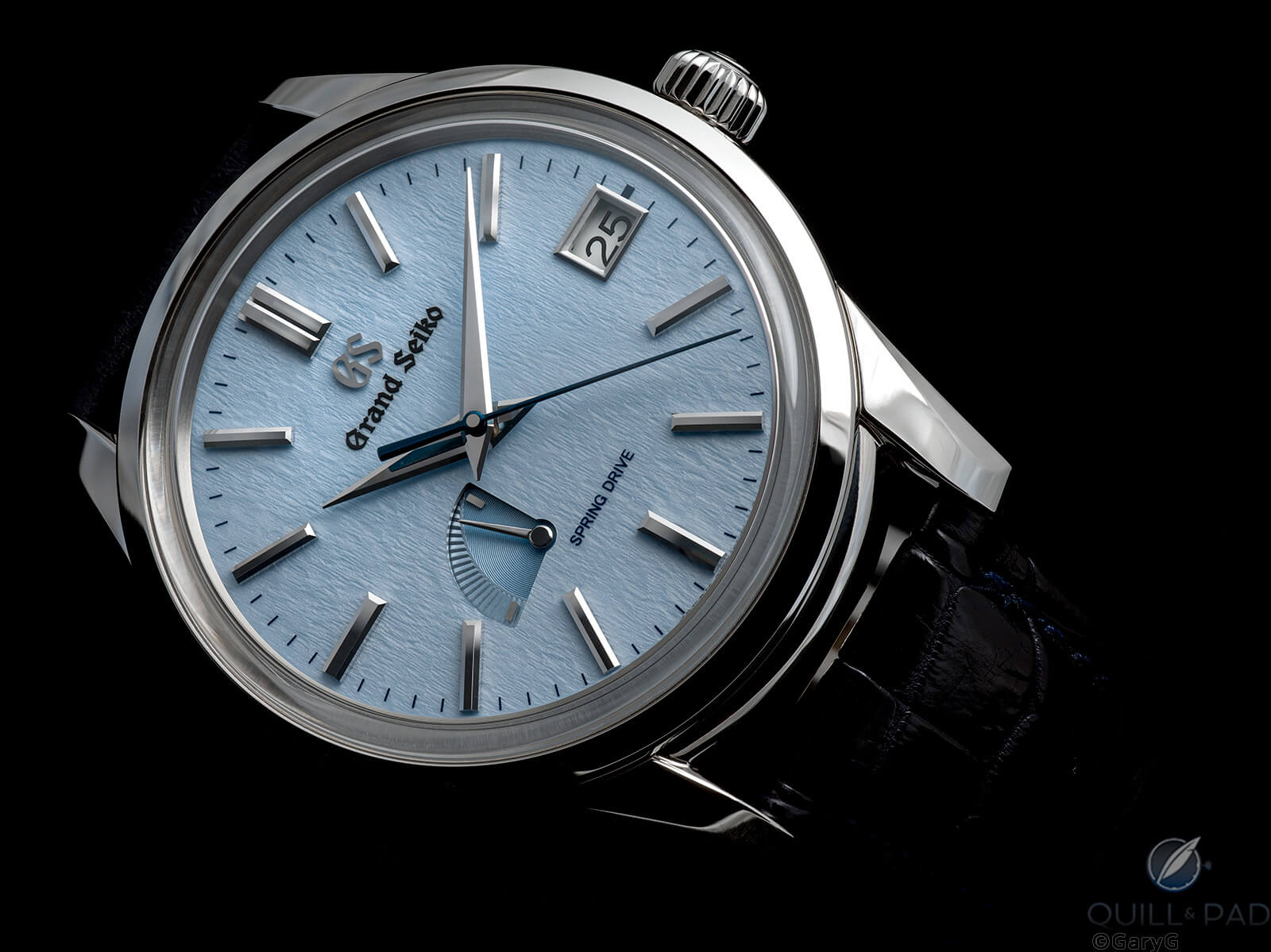
Grand Seiko Spring Drive Blue Snowflake
Spring Drive
Caliber 9R65 Spring Drive is currently the most standard of Grand Seiko’s 9R Spring Drive movements. Since the Spring Drive’s advent in 1999, the power reserves on these have steadily improved. Today, the piece I’m reviewing has a 72-hour power reserve that automatically winds with the barest of wrist movement.
Here’s what I learned of how the Spring Drive works. First, it has no batteries but does generate its own electrical current. This current comes from the mainspring unwinding. Think of how the generator for a bicycle light generates current as the wheel turns. Similar thing here.
Spring Drive consumes the electrical current equivalent of 1/300,000,000 of that used to power a single LED bulb.
A quartz oscillator and an integrated circuit-controlled rotor use the electrical power. The quartz oscillator vibrates at exactly 32,768 Hz, transmitting a precise reference signal to the integrated circuit, which compares the reference signal from the quartz oscillator with the revolution speed of the glide wheel turning in only one direction (clockwise, of course) rather than back and forth.
That’s how the second hand moves with a Zen-like smooth motion over the textured snowy dial.
The integrated circuit applies a magnetic brake when the glide wheel spins too fast. This regulates movement of the hands with a precision not seen before in mechanical watches.
Grand Seiko says this watch is accurate to +/- 1 second/day and +/- 15 seconds per month. The company also says that owners often experience better rates. That was true of my time with the Blue Snowflake. It was accurate to one second ahead during the entire week I had it – on my wrist and in a watch winder.
Care
This watch is no Rolex Submariner. So, yes, it does require more care in the handling of it. Then again, it wasn’t designed for the environments the Sub was.
Grand Seiko recommends not allowing the sun to beat down on the dial for extended periods and not exposing the watch to temperatures below 5°C or above 35°C.
Also, keep the watch away from areas of strong magnetism and static electricity. Keep it out of dusty environments. Don’t expose it to high humidity. And finally, no strong vibrations, please. Of course not. There’s a quartz crystal inside vibrating away at precisely 32,768 Hz.
But it is water resistant to 10 bar and without a screw-down crown.
Final assessment
The Grand Seiko Blue Snowflake is an extraordinary timepiece. It’s beautiful. It’s uncommon and rare. Its design appears simple yet is singularly complex.
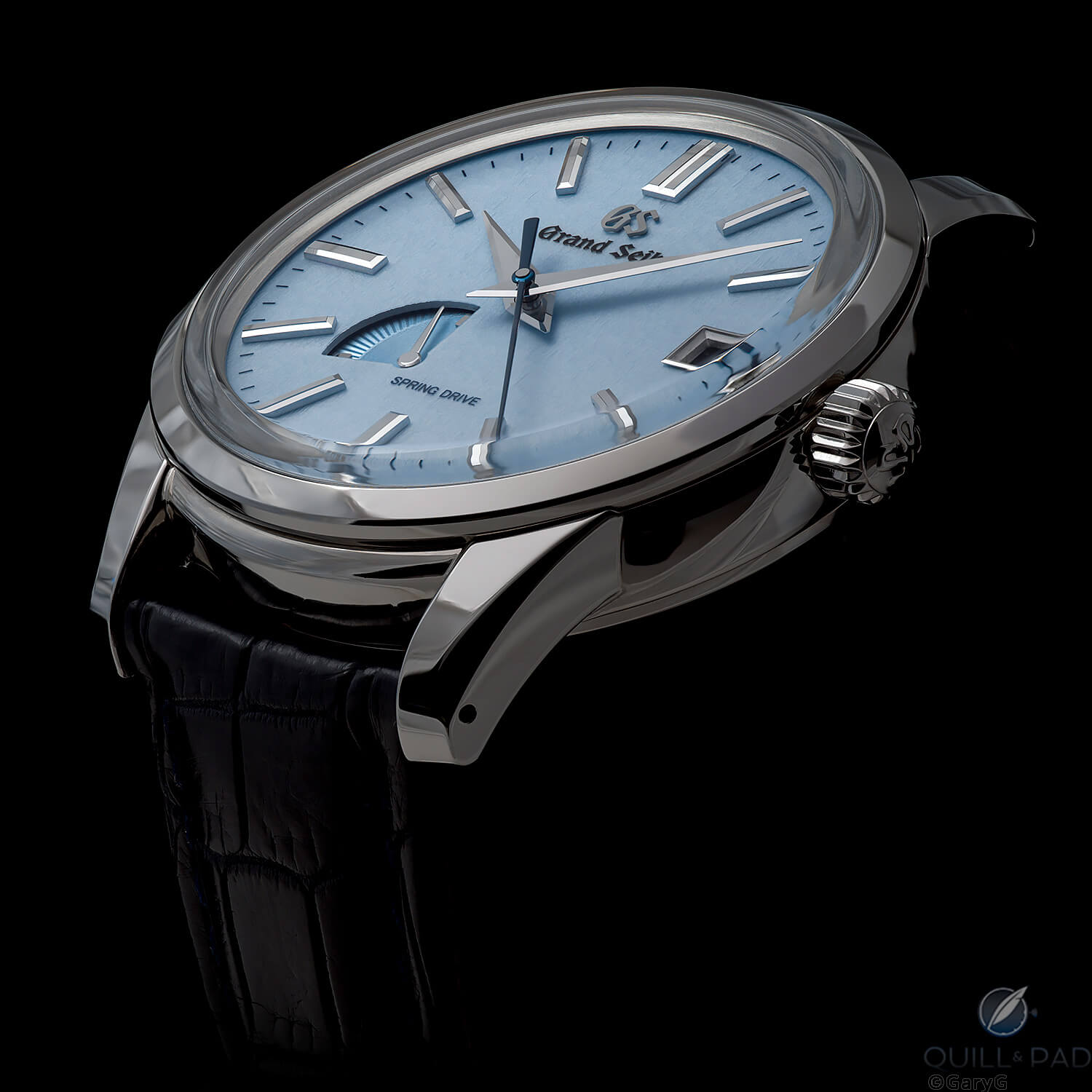
Grand Seiko Spring Drive Blue Snowflake
For me, the Snowflake is a work of art created by some of the industry’s finest artisans. The few problems I found are easily remedied, and I can live with those that aren’t. After enjoying it for a while, I’m beginning to think this watch deserves a place in my modest collection.
For more information, please visit www.grand-seiko.com/us-en/special/sbga407.
Special thanks to GaryG for the outstanding photography.
Quick Facts Grand Seiko Blue Snowflake Reference SBGA407
Case: 40.2 x12.8 mm, stainless steel
Dial: blue stamped “snowflake” pattern
Movement: Seiko Spring Drive Caliber 9R65, automatic winding, power reserve 72 hours, 32,768 vph frequency
Functions: hours, minutes, seconds; date, power reserve
Price: $5,800
You may also enjoy:
Grand Seiko Spring Drive Chronograph GMT SBGC203: You Can Have It All
Grand Seiko’s Urushi Dials Give The Elegance Collection A Competitive Edge (And Eye Candy)
Seiko Celebrates 20th Anniversary Of Grand Seiko 9S Caliber With 4 New Models
Leave a Reply
Want to join the discussion?Feel free to contribute!



Chris, thank you, of all the articles I have read about Seiko Spring Drive watches, yours is the first to mention the restrictions Seiko imposes on the wearer. As someone who likes to be able to wear a watch under normal conditions, not being able to wear it under bright sunlight for extended periods is unacceptable Again thank you for bringing this to our attention.
I had to get my owner’s manual out to check this. Grand Seiko says not to store or wear under the listed conditions for EXTENDED PERIODS. I have had no problems with mine during normal wear, including riding a motorcycle. I have magnetized a couple of watches, but never a Spring Drive which leads me to believe that only normal precautions are needed. (If magnetism is a major issue for you, may I suggest Omega?) If a watch is on your arm and your skin temperature falls below 5C, your watch is no longer your problem. Unless you operate a jack hammer for a iving, I wouldn’t worry about vibration. As far as sun on the dial, I seem to recall a few other brands having “tropical dials”.
In short, I would not worry about these “restrictions” any more than most other watches in the dress/sport category.
Seiko makes a beautiful stainless steel bracelet for the Blue Snowflake: AA1B811J9
I bought at ‘Carat & Co.’
It really saved the watch for me. Perfection.
Hi Shirley,
I have an update for you about your concerns of sunlight on the Blue Snowflake dial. Forget about it. I’ve had mine for almost 9 months now. I wear it often in the strong So Cal sunlight. There has been no change in the dial color. No fading. Nothing. I’d say GS’s cautionary note on avoiding strong sunlight was overstated.
I asked the boys at Grand Seiko Beverly Hills to please get me the steel bracelet. They finally got it after a waiting period of 7 months. I must say the bracelet is a game changer so far as the wearability goes. Now I don’t worry about it so much and wear it several times a week in all environments.
I highly recommend this watch with the steel bracelet.
Best,
Chris
Hi Shirley,
Chris here. Thanks for the comment. Perhaps I made the warnings a bit too strong. When I read in the Blue Snowflake instruction manual, I too paused when I saw the caution about strong sunlight. I live in Southern California where it’s sunny all year long and I’m outdoors quite a bit. Still, I took GS’ caution maybe a bit differently than you. To me, leaving it laying on the chaise lounge poolside for 10 hours at a time could be a problem if you did this every single day. I don’t do this. When GS finally sends me the steel bracelet made for this piece I plan on taking it in the water occasionally. It’s good for 10 bar, after all. And I’ll wear it whenever I wish on sunny days as well as overcast without a thought to any possible damage. Long way around saying, I trust the GS Giant to have my back. If things don’t work out that way, then I’m confident they’ll make it right.
All the best,
Chris
Love the blue dial even though the wrist shot it’s white……a beauty however.
I have the white snowflake (purchased from Grand Seiko main office in Tokyo no less !) which has the same mechanism. These are terrific watches. A bit jealous of the blue now ….
Hi Edward,
The white dial is what caught my eye when it was first introduced. I immediately thought it would be a great “tuxedo” watch–formal but with that dash of verve that only you notice. Perfect. I have a follow-on article about the Blue Snowflake coming out in the coming weeks. Hope you like it as well.
–Chris
If this had an inverted blue date-wheel it would be perfect. As it is, I could probably live with it. The Snowflake is officially a design classic now. But please please please, can luxury watch companies pay attention to this feature? I mean, how difficult is it to print a little circle of plastic??
The idea is that the white date wheel provides contrast and makes it easy to read at a glance. Not everything in life has to match like pajama tops and bottoms ( or be perfect ). It’s the little imperfections that make things interesting and sometimes more beautiful, like this watch. The power reserve indicator suggests an imprint in the snow and adds to this. Lucky are some to live with this dial.
I don’t think it’s a legibility issue, Stefan, the same colors inversed on a date wheel offer the same contrast: black on white = white on black.
Regards, Ian
Agreed.But Tam o’ Banter was suggesting a blue date wheel not black, and I guess ( but could be wrong) was imagining the blue to match the dial.A black number on white ( as is ) does give more contrast and legibility against the powder blue. White numbers on black would be even better! I’m pretty happy with it, though I do find it odd that Grand Seiko makes such an accurate movement in terms of time keeping but then includes a date function that can’t tell the difference between months with 30 and 31 days and requires the user to inform the watch about this! Room for improvement there.Not sure if Spring Drive would be compatible with an annual calendar function.
I visited an AD to have a good look & possibly buy the white snowflake (SBGA211) & was mesmerised by the beautiful sweep of the second hand, the incredible detail & amazing Zaratsu polishing.
I was so close to pulling the trigger but couldn’t get passed the pointless power reserve indicator.
All my watches are autos & I’ve never, ever thought they were lacking an indicator.
If they are out of steam, I turn the crown a few times before they go on the wrist. If they are ticking when I pick them up, they go straight on the wrist.
This clutter put me off.
GS do offer manual Spring drives without the reserve indicator so maybe one day I’ll pick one up but, in the meantime, I’m looking at the HiBeats.
Certainly the best review I have seen, not only on this particular GS model, but on the Spring Drive as well. Especially the detailed photos and descriptions of the various movement parts! I absolutely love this watch, having seen it in real life. I was never a fan of the power reserved indicator, but I have to make an exception in this case. The details on the indicator are absolute art work, especially attention to gradations, from lighter to darker as the watch is more fully wound. Perhaps it’s the lighting, but I could swear – even when I saw the watch in real life – that the background of the date wheel is silvery. Whatever it is, it all seems to work together. Never having been a fan of neither power reserve indicator nor date window, I find myself becoming increasingly attracted to all details of this watch. Thanks again for a wonderful review. Cheers, Carl
You don’t put the fuel indicator on the back of a car, why would you put it on the back of a watch.? Also in this case the indicator enhances the snowflake theme by suggesting an imprint in the snow, again in this case. Being in the shape of a Japanese paper fan, which s perfectly in keeping with the Japanese aesthetic.
No need to change anything. Fortunately, it’s designed by Grand Seiko not watch critics who somehow have to match up and balance every little detail like pyjamas.
What a fantastic review! The Grand Seiko Blue Snowflake SBGA407 really captures the essence of Japanese craftsmanship. The subtle details and stunning dial make it a true standout piece. I appreciate the insights on how it wears on the wrist – definitely helps in visualizing its presence. Thank you for such an informative post!
I’ve always been captivated by the Blue Snowflake’s unique dial texture and the way it captures light. Your detailed observations really brought the watch to life! The craftsmanship of Grand Seiko is truly something special. Looking forward to seeing more of your reviews!
What a fantastic review of the Grand Seiko Blue Snowflake! The craftsmanship and attention to detail are truly impressive, and I love how you highlighted its unique dial texture. Seeing it on the wrist really showcases its elegance. It’s definitely a piece that stands out in any collection!
What a stunning review! The Grand Seiko Blue Snowflake SBGA407 truly captures the beauty of nature on the wrist. I love how you’ve highlighted the intricate details and the unique dial texture. It really makes me appreciate the craftsmanship that goes into these pieces. Great job!
Absolutely loved the detailed insights on the SBGA407! The “Blue Snowflake” dial captures light in such a mesmerizing way. It’s clear why this timepiece is so beloved among Grand Seiko enthusiasts. Thanks for sharing your thoughts!